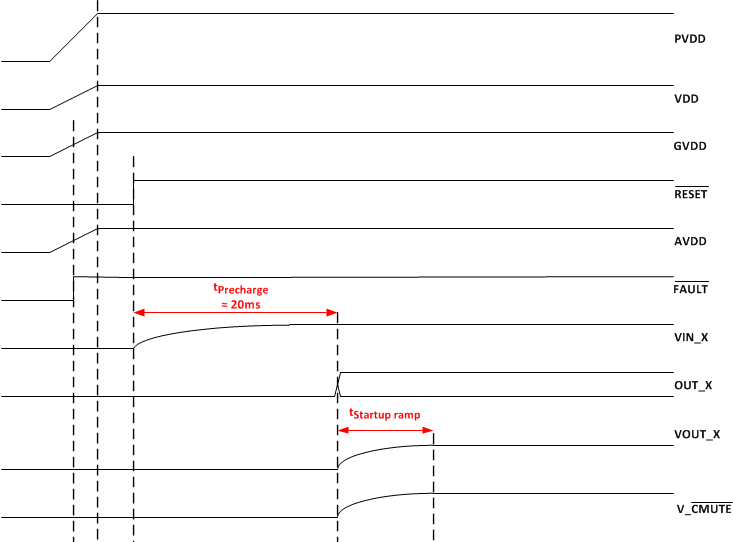ZHCSQ35 November 2022 TPA3223
PRODUCTION DATA
- 1 特性
- 2 应用
- 3 说明
- 4 Revision History
- 5 Device Comparison
- 6 Pin Configuration and Functions
- 7 Specifications
- 8 Parameter Measurement Information
-
9 Detailed Description
- 9.1 Overview
- 9.2 Functional Block Diagrams
- 9.3 Feature Description
- 9.4
Device Functional Modes
- 9.4.1 Powering Up
- 9.4.2 Powering Down
- 9.4.3 Device Reset
- 9.4.4 Device Soft Mute
- 9.4.5
Device Protection System
- 9.4.5.1 Overload and Short Circuit Current Protection
- 9.4.5.2 Signal Clipping and Pulse Injector
- 9.4.5.3 DC Speaker Protection
- 9.4.5.4 Pin-to-Pin Short Circuit Protection (PPSC)
- 9.4.5.5 Overtemperature Protection OTW and OTE
- 9.4.5.6 Undervoltage Protection (UVP), Overvoltage Protection (OVP), and Power-on Reset (POR)
- 9.4.5.7 Fault Handling
- 10Application and Implementation
- 11Device and Documentation Support
- 12Mechanical, Packaging, and Orderable Information
9.4.1 Powering Up
The TPA3223 does not require a power-up sequence because of the integrated undervoltage protection (UVP), but TI recommends to hold RESET low until PVDD supply voltage is stable to avoid audio artifacts. The outputs of the H-bridges remain in a high-impedance state until the gate-drive supply (GVDD) and AVDD voltages are above their UVP voltage thresholds (see the Section 7.5 table of this data sheet). Doing so allows an internal circuit to charge the external bootstrap capacitors by enabling a weak pull-down of the half-bridge output as well as initiating a controlled ramp up sequence of the output voltage.
 Figure 9-13 Startup
Timing
Figure 9-13 Startup
TimingWhen RESET is released to turn on TPA3223, FAULT signal turns low. FAULT stays low until AVDD reaches the undervoltage protection (UVP) voltage threshold (see the Section 7.5 table of this data sheet). After a pre-charge time to stabilize the DC voltage across the input AC coupling capacitors, the ramp up sequence starts and completes once the CMUTE node is charged to the final value.